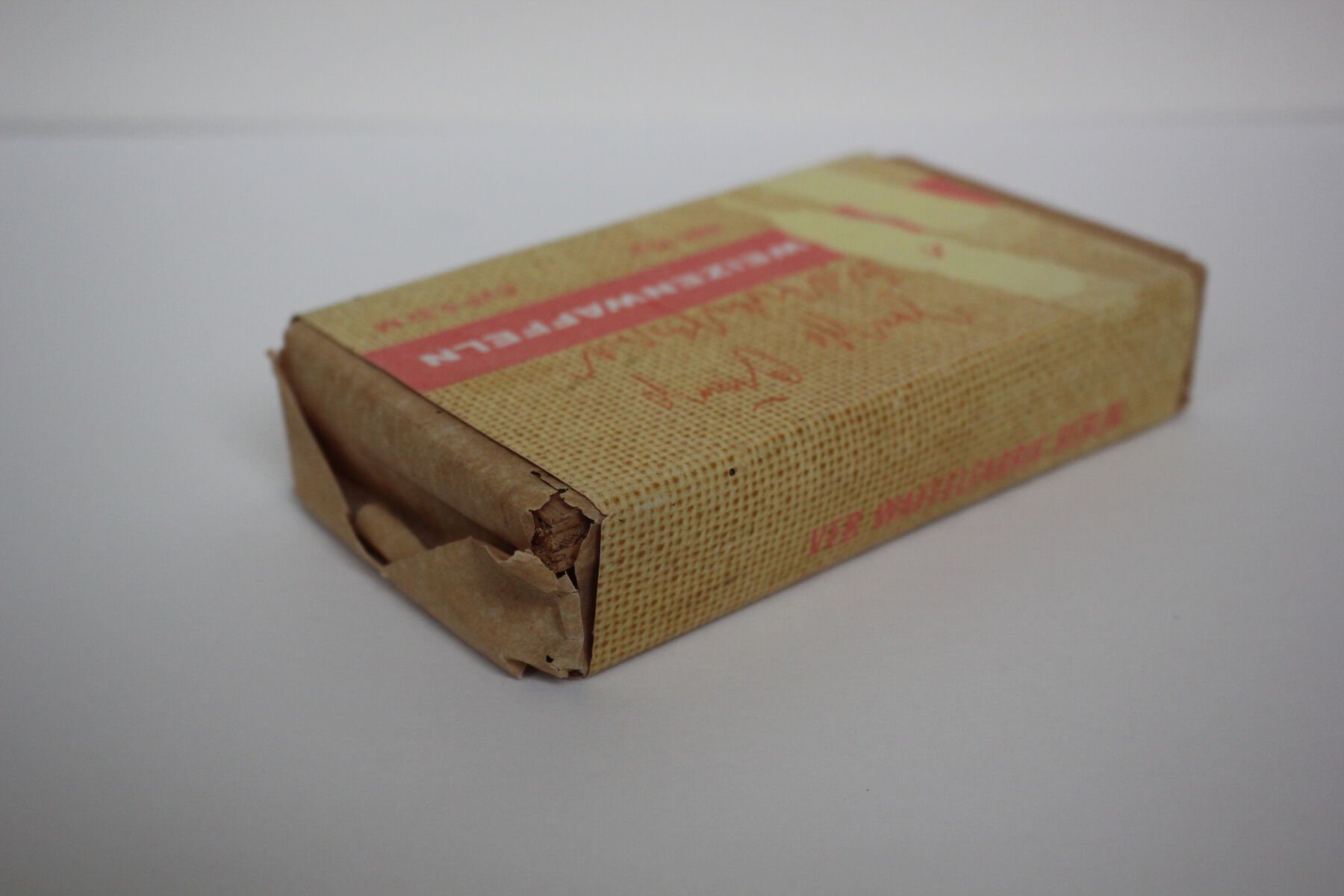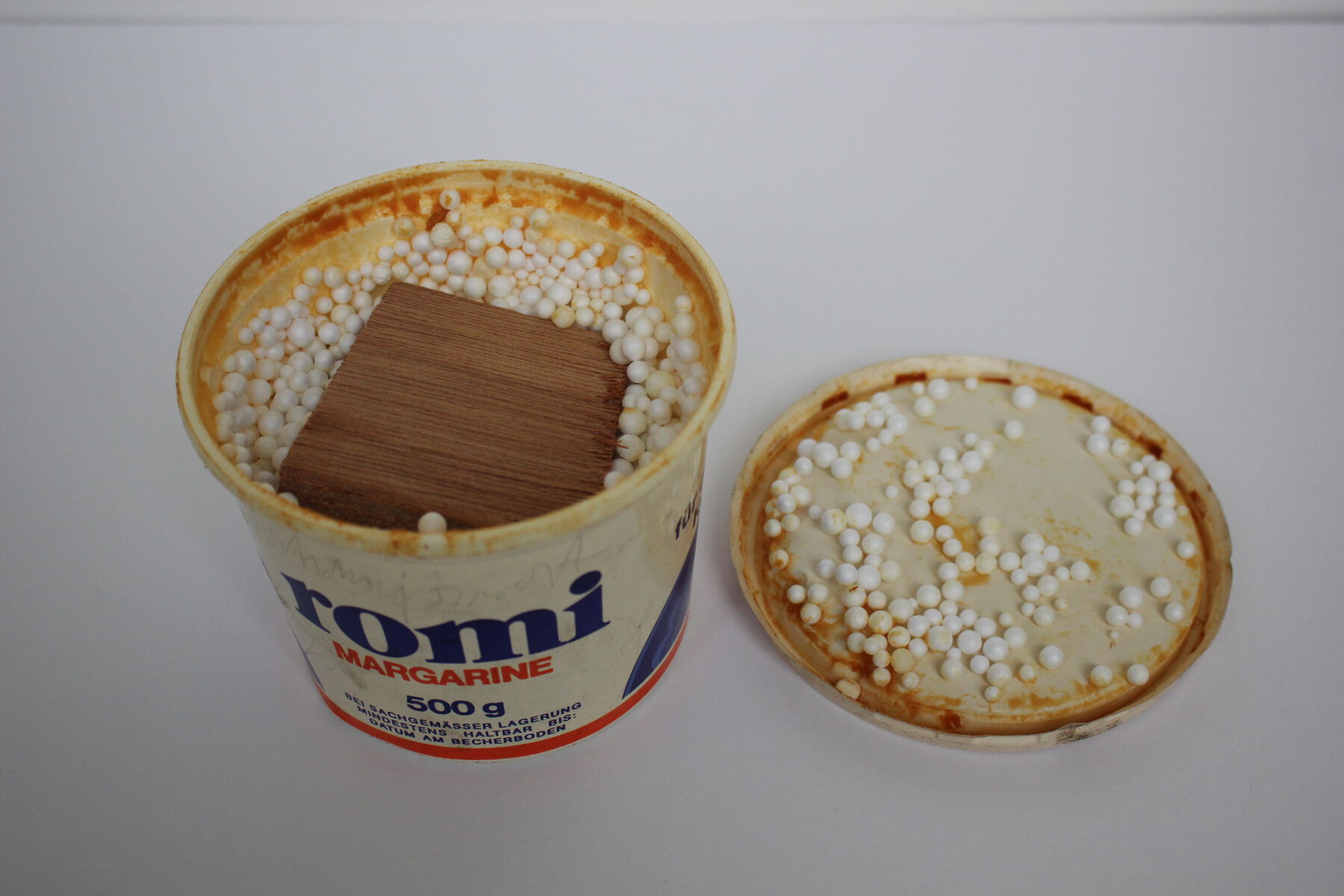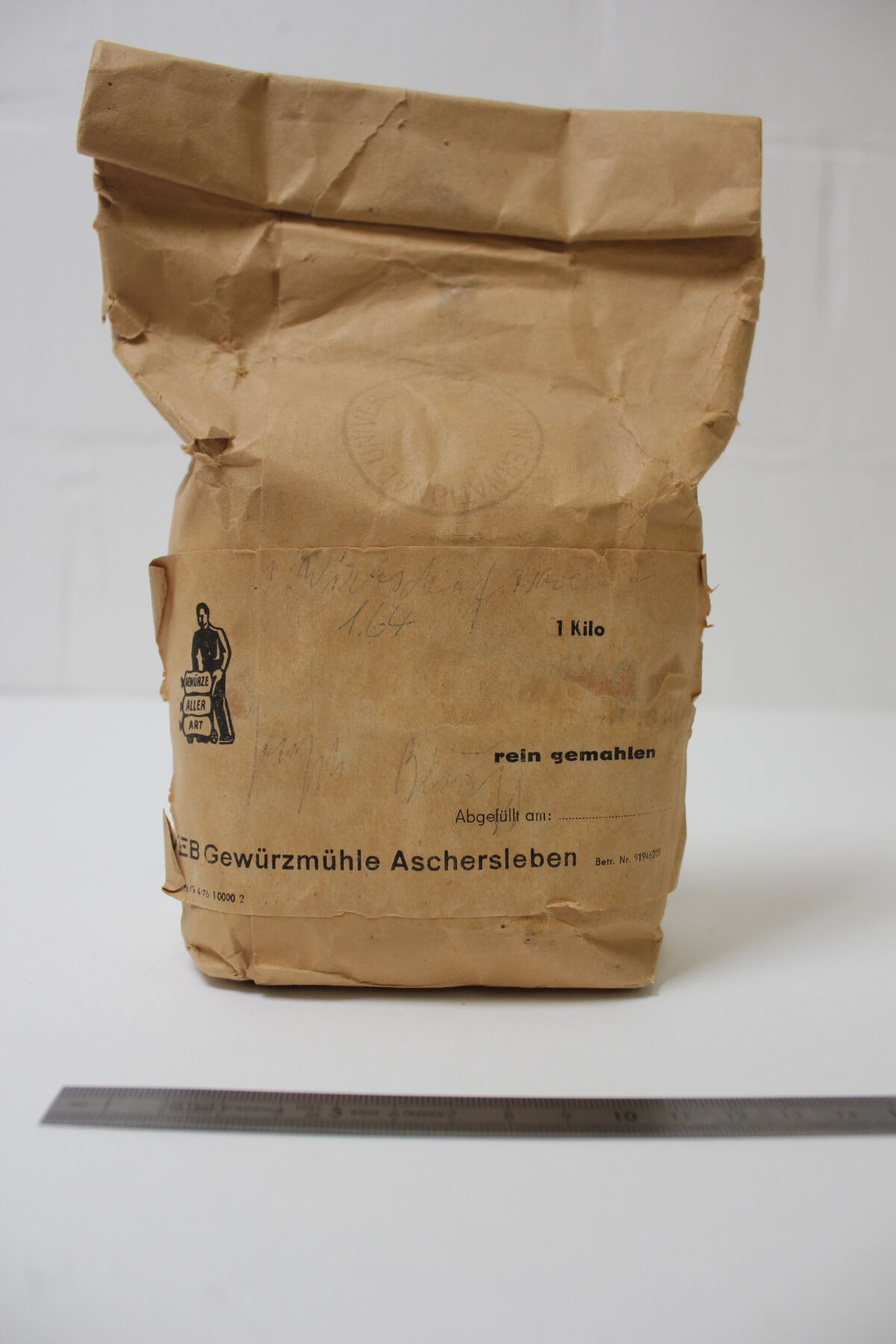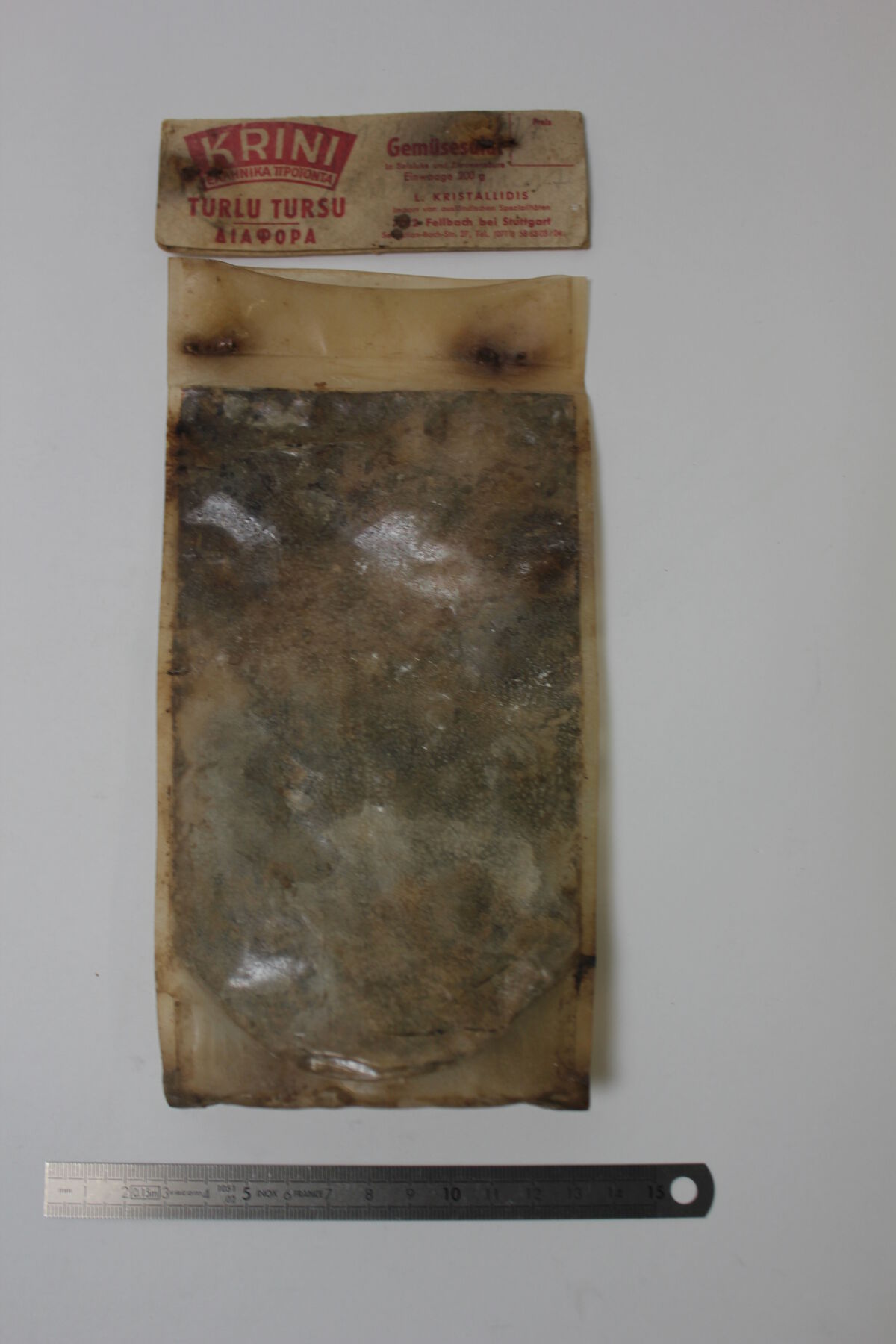17. Stabbing Our Own House: A Biography of Joseph Beuys’s Wirtschaftswerte
- Rebecca Heremans
- Katrien Blanchaert
Wirtschaftswerte (1980, fig. 17.1), an installation artwork by Joseph Beuys (1921–1986), is one of the most iconic artworks in the collection of the S.M.A.K. museum in Ghent, Belgium. Its history and conservation appeal to the imagination, mainly due to the ephemeral nature of some of its elements.
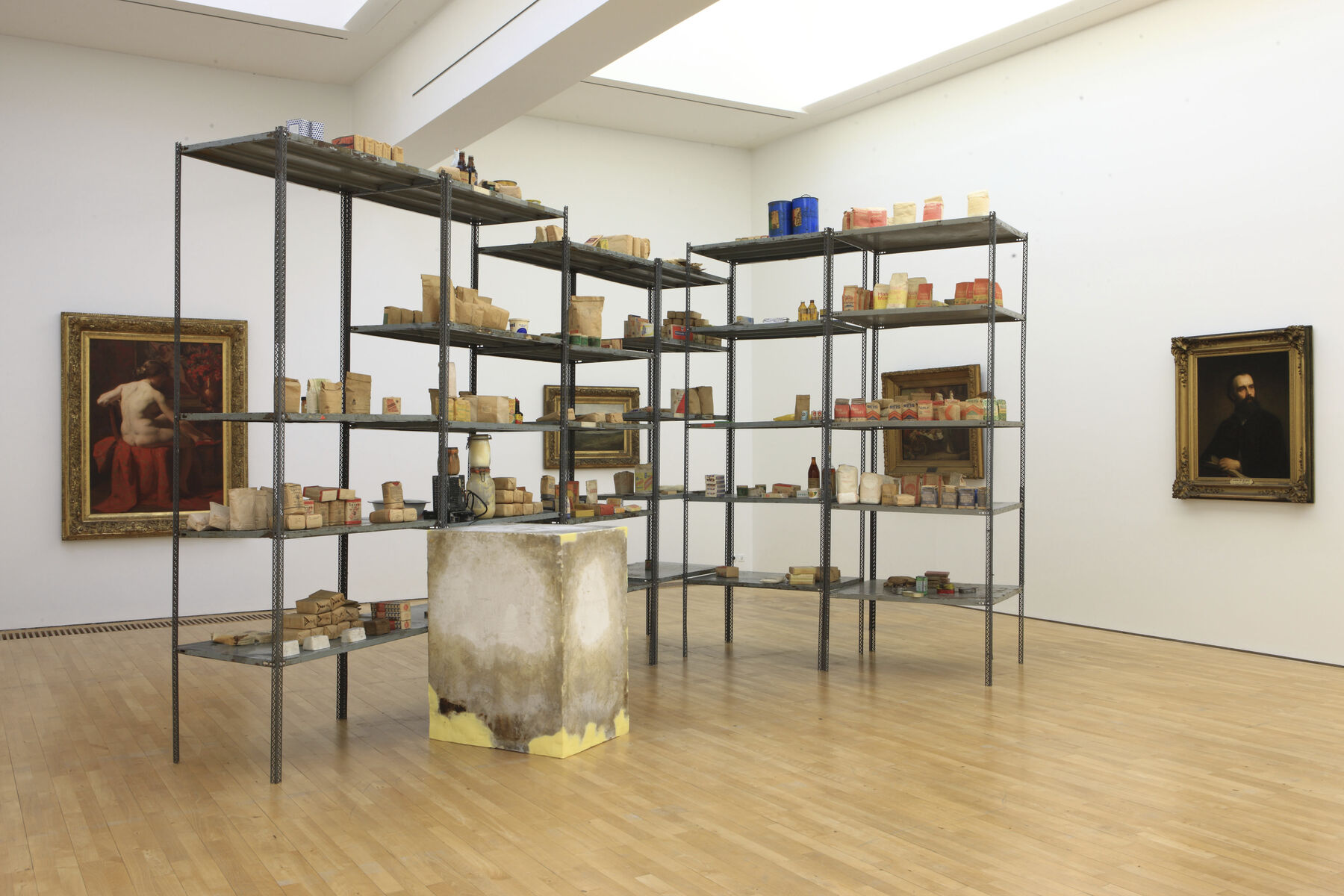 Figure 17.1
Figure 17.1To understand the origin and history of Wirtschaftswerte, it is necessary to first sketch the museum’s history. S.M.A.K. is a museum with a collection of contemporary artworks dating from the 1940s to the present. In 1957 an organization called Vereniging voor het Museum voor Hedendaagse Kunst (VMHK, or Association for the Museum for Contemporary Art) was founded by a group of private collectors and art lovers interested in contemporary art. From 1975 to 1999, Jan Hoet, founder and former director of S.M.A.K., was given the opportunity to put the VMHK collection (and more) on display in parts of the Museum voor Schone Kunsten (Ghent Museum of Fine Arts). In 1999 VMHK moved to its own building on the other side of the street and changed its name to the Stedelijk Museum voor Aktuele Kunst (S.M.A.K.).
Before that, in 1980, Hoet curated the legendary exhibition Kunst in Europa na ’68 (Art in Europe after ’68), in which Art and Language, Mario Merz, Gilbert & George, Panamarenko, and many other artists took part. It was at that time, in one of the smaller halls near the center of the museum building, that Beuys created Wirtschaftswerte with his assistants. Several of the works made specifically for this exhibition were later added to the museum’s collection, and Beuys’s installation was one such. Wirtschaftswerte was acquired in December 1980. Hoet bought it from Beuys himself, at a friend’s price. Since VMHK was a municipal museum, the acquisition of this piece needed to be approved by the city council. There are records of heated discussions among the Ghent councilors about the purchase. Some had doubts about its “artistic qualities”; others expressed concerns about the transient nature of certain constituent materials and their conservation (, 180–81).
The title, Wirtschaftswerte, can be translated as “economic values.” The content and concept was part of Beuys’s so-called Wirtschaftswertprinzip (economic value principles), an idea that had occupied the artist since 1977. He used art as a changing medium to raise social and/or political issues. This installation suggests reflection on the contrasts between East and West, and all their different aspects ().1
The components break down into four general categories. First, there are six metal racks. These were bought by the German publisher Gerhard Steidl at a pawnshop or metal dealer in Berlin (, 178).2 Since they were secondhand, the racks already showed wear in 1980. Positioned on the racks are a variety of packaged food items and other provisions: sugar, cookies, beer, rice, sulfur, honey, tea, barley, millet, salt, rabbit pâté, chocolate, bandages, batteries, and more. Beuys began collecting these packages from the former German Democratic Republic several years before the creation of Wirtschaftswerte. His friend, the graphic designer Klaus Staeck, had family in the GDR and regularly brought packages to West Germany for Beuys. While it is assumed that in 1980 there were about 510 packages in the installation, today there are only 462 packages. Every item shows the artist’s signature and the inscription “1 Wirtschaftswert” (fig. 17.2). The third element of the installation is a rectangular plaster block. This block had been in the artist’s studio since the 1960s and became part of a fixed work in 1980, specifically in front of the metal racks of Wirtschaftswerte (, 21). The corners of the block were intentionally damaged by the artist, and he used butter—a common product in his oeuvre—to restore the rectangular shape (fig. 17.3). On the top of the block, Beuys has written “Der Eurasier läßt schön Grüßen. Joseph” (The Eurasier sends kind greetings). While the butter is removed at the end of each exhibition, it has penetrated the plaster over the years, giving the work quite a specific aroma. And last but not least, wherever Wirtschaftswerte is displayed, several paintings are shown alongside it. There are no specific paintings that belong to the installation; the subject matter may vary, but, per a S.M.A.K. condition report from 1999, the paintings must date from between 1818 and 1883, the life span of Karl Marx.
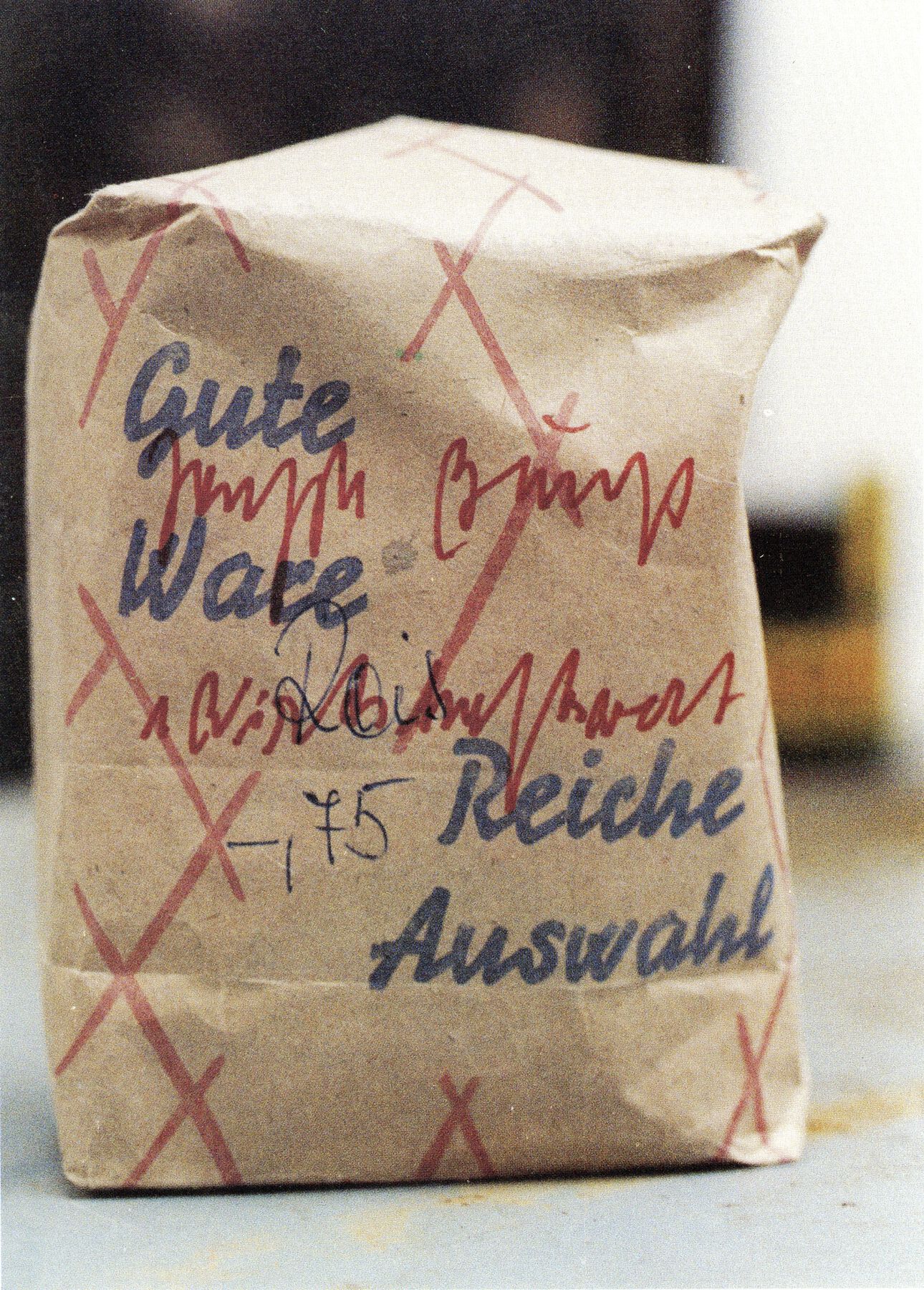 Figure 17.2
Figure 17.2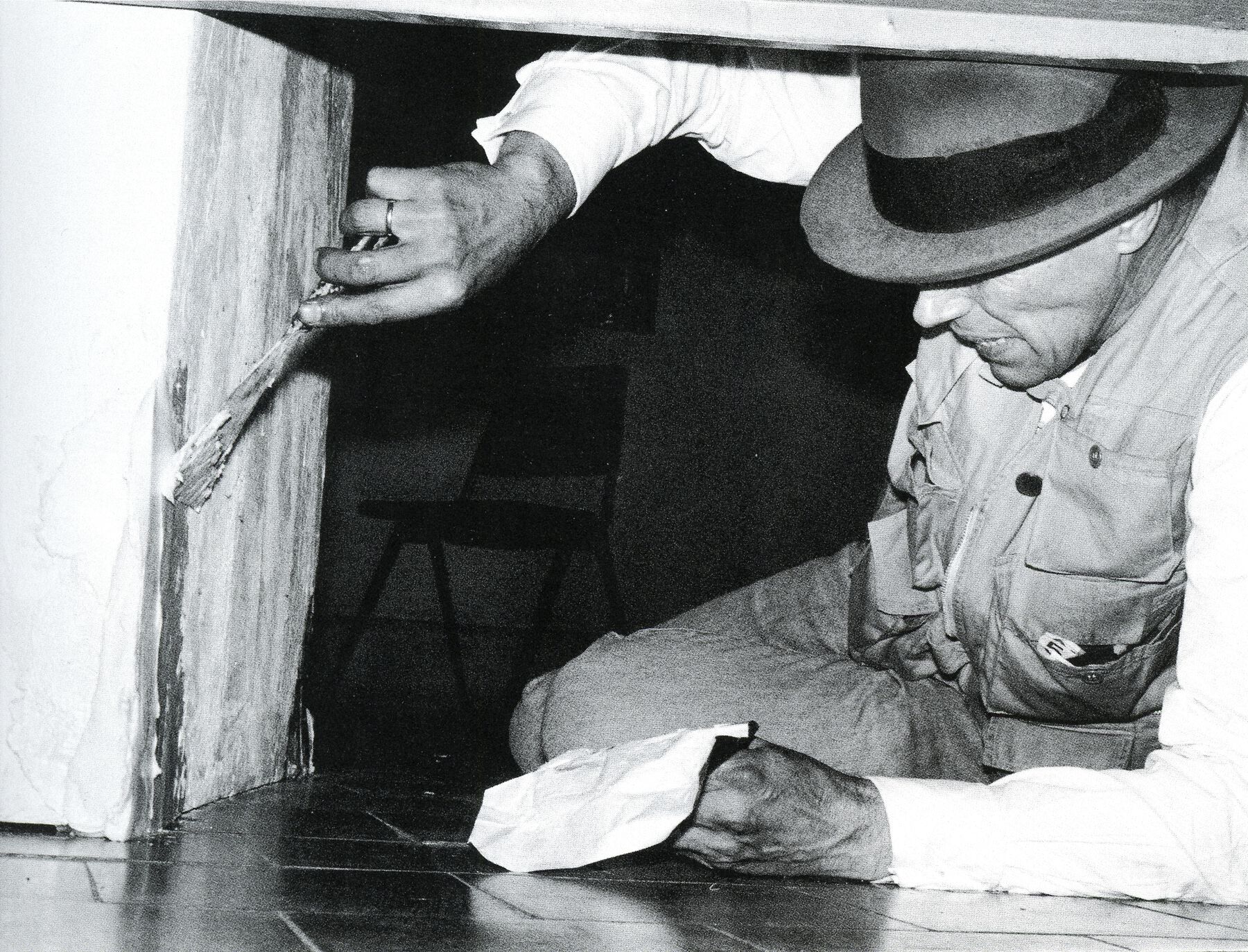 Figure 17.3
Figure 17.3Research
In order to create a decision tree to assist in the future conservation and/or restoration of the installation, particularly the packaged food items, it was necessary to conduct research that highlighted its different aspects. The rich history of the work, the variety of materials present, and the ethical issues that arose when thinking about the conservation and restoration of specific elements were all investigated. In this way, it was possible to make substantiated compromises between different considerations ().
To better understand the work’s current condition, its history was investigated from its purchase to the present day. In 1990 Das Wirtschaftswertprinzip was published: a book full of photographs by Klaus Staeck and Gerhard Steidl showing the original installation process of Wirtschaftswerte at Kunst in Europa na ’68. This book was crucial for the historical and technical research on the installation’s various elements and materials.
Also, apart from its origin story, a few key events are worth noting. A thorough search through the S.M.A.K. archives in 2014 revealed that Wirtschaftswerte had definitely been displayed at least thirty-eight times, and perhaps more than that. Regarding the conservation of the work, several treatments had been undertaken since the establishment of the museum’s restoration department in 1998. Notes referencing a treatment in 1999 were found, but no specific details were mentioned. Presumably it was for controlling insects.3 In 2002 a design for crates and packaging of the different parts was formulated. The intent was to store the packaged items in an environment with reduced oxygen levels, but this was too difficult to realize in loan situations (, 180). In 2011 seventy-two packaged food items were treated by two freelance restorers. Information about the treatments is available, but no other research on Wirtschaftswerte was carried out at that time. And since this intervention, no further conservation treatments have been completed to date.
The further one goes back in time, the less is known about the conservation and management of the installation. There are no written records about Wirtschaftswerte’s conservation between 1980 and 1999; most of the information from that period comes from oral sources and loan documentation. The latter proves that Beuys was closely involved when Wirtschaftswerte was requested for loan from the VMHK in 1984 for the exhibition Von hier aus. Zwei Monate neue deutsche Kunst in Düsseldorf presented by the city of Düsseldorf (, 187). In Düsseldorf, Beuys made a few changes to the installation, the most obvious of which was the addition of chicken wire around the metal racks to prevent the packaged items from being stolen. Afterward it was decided that this mode of presentation was a one-off. The installation was the first time Wirtschaftswerte was put together with Beuys present since the original in Ghent. He noted at that time that more than half of the packages present on the racks no longer contained their original contents. These replacements were made in 1983 or 1984 by a then museum employee due to biological attack by insects.4 Beuys objected to the difference in weight of the substituted material compared to the original and suggested replacing the affected contents with champagne chalk or sand (, 24). Alas, this all happened during a stage in which, as previously mentioned, no records were kept, making it impossible to understand the thoughts behind those decisions. The exact number of packaged items present in 1984 is uncertain, but of the 462 that remain today, 292 contain non-original content.
Packages that had their contents replaced were filled with a variety of materials. Many of these were not suitable for long-term conservation, and some even caused damage to the packaging. Among the replacement materials were wooden lath, sawdust, and chalk, but the majority of the foodstuff packages were filled with polystyrene (fig. 17.4a, fig. 17.4b). In order to document the packages’ different contents, an inventory was made in 2014 with a focus on the materials present and their condition (table 17.1). This document also includes suggestions for suitable restoration treatments for the exterior of each package. More than a handful of damage types were observed: fading and/or discolorations, brittle paper, faded artist signatures, mechanical damage of the paper support, sticky and/or dirty plastic or glass jars, splintered plastic foils, bulging tins, and so on (fig. 17.5a, fig. 17.5b). It was also noted that identical-looking packages sometimes had different contents.
| Rack | Object | Material(s) | Condition of whole (good/moderate/bad) | Condition support (outside) (good/moderate/bad) | Original content present? (Yes + what /No) | Non-original content (What?) | Secondary support present? (Yes + what/No) | Other, previous restorations (What?) | Current damage (What?) | Conservation/restoration treatments: suggestions |
|---|---|---|---|---|---|---|---|---|---|---|
| 5A | Ricolit Rotbraun Holzschützender Anstrichstoff (green label) | Metal can + paper label | Good | Moderate | Yes, sort of varnish | / | No | No | Corrosion Loss of paint layer - can Drips of content - outside can Deformation (dent) - can Stains | Dry cleaning Treatment of corrosion (?) |
| 5A | Ricolit Rotbraun Holzschützender Anstrichstoff (red label) | Metal can + paper label | Good | Moderate | Yes, sort of varnish | / | No | No | Corrosion Loss of paint layer - can Drips of content - outside can Small deformation (dent) - can Stains | Dry cleaning Treatment of corrosion (?) |
| 5A | Roggen Vollkorn Waffeln | Paper + sort of tracing paper + piece of transparent tape | Moderate | Moderate | No | Styrofoam | No | No | Discoloring Thinned/weakened support Tears/holes Exit holes by bugs Yellowed + brittle tape Loose sealing Stain of adhesive - removed sticker | Dry cleaning Reinforcement of weakened zones Mending of tears/holes Mending of sealing Removal of tape/adhesive rests Adding a secondary support (?) |
| 5A | Berliner Knusperbrot | Paper + sort of tracing paper | Moderate | Moderate | No | Ethafoam + silicone | Yes, tyvek | Yes (2011): Mending of tears New content Secondary support | Discoloring Thinned/weakened support Tears Loose sealing | Dry cleaning Reinforcement of weakened zones Mending of tears Mending of sealing |
| 5A | Kinderberuhigungstee | Cardboard | Good | Moderate | Yes (?), tea | / | Yes, plastic (audible) | No | Discoloring Thinned/weakened support Stains | Dry cleaning Reinforcement of weakened zones Adding a secondary support (?) |
| 5A | Stoffwechseltee | Cardboard | Good | Moderate | Yes (?), tea | / | Yes, undefined plastic (audible) | No | Discoloring Thinned/weakened support Stains | Dry cleaning Reinforcement of weakened zones Adding a secondary support (?) |
| 5A | Schlankheitstee (blue sticker "5") | Cardboard | Good | Moderate | Yes (?), tea | / | Yes, undefined plastic (audible) | No | Discoloring Thinned/weakened support Stains | Dry cleaning Reinforcement of weakened zones Adding a secondary support (?) |
| 5A | Schlankheitstee (blue sticker "6") | Cardboard | Good | Moderate | Yes (?), tea | / | Yes, undefined plastic (audible) | No | Discoloring Thinned/weakened support Stains | Dry cleaning Reinforcement of weakened zones Adding a secondary support (?) |
| 5A | Hunger's Familien Frühstückstee (blue sticker "7") | Cardboard | Good | Moderate | No (?) | Styrofoam + piece of cardboard (?) | No | No | Discoloring Thinned/weakened zones Loose pieces | Dry cleaning Reinforcement of weakened zones Adding a secondary support (?) Mending of loose piece |
| 5A | Hunger's Familien Frühstückstee (blue sticker "8") | Cardboard | Good | Good | No | Styrofoam | No | No | Discoloring Thinned/weakened zones | Dry cleaning Reinforcement of weakened zones Adding a secondary support (?) |
| 5A | Hunger's Familien Frühstückstee (blue sticker "9") | Cardboard | Good | Good | No | Styrofoam + piece of cardboard (?) | No | No | Discoloring Thinned/weakened zones Glue stain at bottom | Dry cleaning Reinforcement of weakened zones Removal of glue stain Adding a secondary support (?) |
| 5A | Hunger's Familien Frühstückstee (blue sticker "10") | Cardboard | Moderate | Moderate | No | Styrofoam | No | No | Discoloring Thinned/weakened zones Loose piece Leaking content package | Dry cleaning Reinforcement of weakened zones Mending of loose piece Closure of packing Adding a secondary support (?) |
12 (?) objects in 1980
12 objects on sketch between 1980-1988
12 objects on German list in 1988
12 objects before 2004
12 objects in 2014
| Rack | Object | Material(s) | Condition of whole (good/moderate/bad) | Condition support (outside) (good/moderate/bad) | Original content present? (Yes + what /No) | Non-original content (What?) | Secondary support present? (Yes + what/No) | Other, previous restorations (What?) | Current damage (What?) | Conservation/restoration treatments: suggestions |
|---|---|---|---|---|---|---|---|---|---|---|
| 5A | Ricolit Rotbraun Holzschützender Anstrichstoff (green label) | Metal can + paper label | Good | Moderate | Yes, sort of varnish | / | No | No | Corrosion Loss of paint layer - can Drips of content - outside can Deformation (dent) - can Stains | Dry cleaning Treatment of corrosion (?) |
| 5A | Ricolit Rotbraun Holzschützender Anstrichstoff (red label) | Metal can + paper label | Good | Moderate | Yes, sort of varnish | / | No | No | Corrosion Loss of paint layer - can Drips of content - outside can Small deformation (dent) - can Stains | Dry cleaning Treatment of corrosion (?) |
| 5A | Roggen Vollkorn Waffeln | Paper + sort of tracing paper + piece of transparent tape | Moderate | Moderate | No | Styrofoam | No | No | Discoloring Thinned/weakened support Tears/holes Exit holes by bugs Yellowed + brittle tape Loose sealing Stain of adhesive - removed sticker | Dry cleaning Reinforcement of weakened zones Mending of tears/holes Mending of sealing Removal of tape/adhesive rests Adding a secondary support (?) |
| 5A | Berliner Knusperbrot | Paper + sort of tracing paper | Moderate | Moderate | No | Ethafoam + silicone | Yes, tyvek | Yes (2011): Mending of tears New content Secondary support | Discoloring Thinned/weakened support Tears Loose sealing | Dry cleaning Reinforcement of weakened zones Mending of tears Mending of sealing |
| 5A | Kinderberuhigungstee | Cardboard | Good | Moderate | Yes (?), tea | / | Yes, plastic (audible) | No | Discoloring Thinned/weakened support Stains | Dry cleaning Reinforcement of weakened zones Adding a secondary support (?) |
| 5A | Stoffwechseltee | Cardboard | Good | Moderate | Yes (?), tea | / | Yes, undefined plastic (audible) | No | Discoloring Thinned/weakened support Stains | Dry cleaning Reinforcement of weakened zones Adding a secondary support (?) |
| 5A | Schlankheitstee (blue sticker "5") | Cardboard | Good | Moderate | Yes (?), tea | / | Yes, undefined plastic (audible) | No | Discoloring Thinned/weakened support Stains | Dry cleaning Reinforcement of weakened zones Adding a secondary support (?) |
| 5A | Schlankheitstee (blue sticker "6") | Cardboard | Good | Moderate | Yes (?), tea | / | Yes, undefined plastic (audible) | No | Discoloring Thinned/weakened support Stains | Dry cleaning Reinforcement of weakened zones Adding a secondary support (?) |
| 5A | Hunger's Familien Frühstückstee (blue sticker "7") | Cardboard | Good | Moderate | No (?) | Styrofoam + piece of cardboard (?) | No | No | Discoloring Thinned/weakened zones Loose pieces | Dry cleaning Reinforcement of weakened zones Adding a secondary support (?) Mending of loose piece |
| 5A | Hunger's Familien Frühstückstee (blue sticker "8") | Cardboard | Good | Good | No | Styrofoam | No | No | Discoloring Thinned/weakened zones | Dry cleaning Reinforcement of weakened zones Adding a secondary support (?) |
| 5A | Hunger's Familien Frühstückstee (blue sticker "9") | Cardboard | Good | Good | No | Styrofoam + piece of cardboard (?) | No | No | Discoloring Thinned/weakened zones Glue stain at bottom | Dry cleaning Reinforcement of weakened zones Removal of glue stain Adding a secondary support (?) |
| 5A | Hunger's Familien Frühstückstee (blue sticker "10") | Cardboard | Moderate | Moderate | No | Styrofoam | No | No | Discoloring Thinned/weakened zones Loose piece Leaking content package | Dry cleaning Reinforcement of weakened zones Mending of loose piece Closure of packing Adding a secondary support (?) |
12 (?) objects in 1980
12 objects on sketch between 1980-1988
12 objects on German list in 1988
12 objects before 2004
12 objects in 2014
Both the appearance and the physical condition of the packaging were taken into account, and terms such as “good,” “moderate,” or “bad” soon came to seem too limited to identify the treatment requirements of the entire object. Also quickly realized was that the failure of the physical structure of the packaging instantly affects the contents, including potential loss. Loss of the package contents complicates the manipulation of the package, and may even disrupt its perception. All these factors confirmed the need for a more elaborate and tailor-made decision-making model for Wirtschaftswerte.
Other Works by Beuys and Ethical Issues
To clarify and define the future needs of Wirtschaftswerte, the research also looked beyond the immediate walls of the museum. Reading about the conservation of other three-dimensional pieces by Beuys and talking to other conservators who care for his work clarified some similarities and differences between this case and others.5 Besides the presence of specific organic materials that he typically used, such as felt, fat, and honey, and the fact that these are often in need of cleaning or other conservation treatments, the most striking similarity appeared to be that caretakers of other sculptures and installations by the artist also asked themselves: “When should conservation stop?” This is because Beuys’s opinion on aging and alteration differed with every artwork, and often these opinions were not recorded at the time they were expressed. It is known that Beuys was aware of the ephemeral aspect of his art (, 215). He once said: “My sculpture is not fixed and finished. Processes continue in most of them: chemical reactions, fermentations, color changes, decay, drying up. Everything is in a state of change” (, 8). But it would be reductive to conclude from this quote that Beuys wouldn’t mind letting his work simply decay. After all, it is also known that he gave advice to the employees of VMHK on “treating” the packages damaged by insects, which shows that he acknowledged the need for conservation treatments (, 24).
On the other hand, Wirtschaftswerte differs most clearly from other Beuys installations in that it doesn’t have a fixed exhibition space. It was shown in numerous venues, and repeated handling caused specific damages. The presence of non-original content in many food packages and the damages that occurred during replacement also seem to be exclusively linked to Wirtschaftswerte. The presence of these non-original contents raised many ethical questions regarding future conservation and/or restoration treatments of the packaged items: What did Beuys think about the aging of this installation in particular? What is more important to the installation: concept or material? Do the non-original contents blemish the meaning of the work? Should non-original content be replaced if it hasn’t harmed the packaging? Are materials that are suitable for long-term conservation in conflict with the artistic intent? What types of damage could or should be tolerated? If the original content is still present, can it be replaced as a preventive intervention if needed? When should a package be considered a total loss? To what extent should the museum let the installation “fade away”? When should the installation as a whole be considered a total loss? Should exhibition copies of the packaged items be considered?
These are just some of the questions that the museum asked itself when thinking about the conservation of Wirtschaftswerte. Since the artist’s current opinion on the conservation of his work can no longer be procured, a compromise must be found between Beuys’s concept and the vision of the museum regarding the conservation of the installation. Considering the varied nature of the packaged items and the different opinions of museum staff, it was not easy to reach conclusive answers. Taking all different aspects of the research into account, it can be concluded that there is no straightforward solution for treating an installation like this one. The most important thing is that decisions made for conserving the packages have a rationale, can be justified, and are implemented uniformly.
Decision-Making Model
The most important ethical questions concerned how far a conservation treatment should go, and what should happen with the current content of the packaged items. To find answers, the most compelling questions about the condition of the packages were included in the decision tree. All packaged items will go through the different steps of the diagram, since all show damage or changes (fig. 17.6).
 Figure 17.6
Figure 17.6The model starts from the following question: “Is the package leaking?” The answer to this question can be yes or no. If a loss of content is noted, further steps proceed on the left side of the decision tree (fig. 17.7). Every effort is made to retain original contents unless they are in poor condition or pose a threat to the condition of the packaging. When the original packaging is in such bad condition that no restoration treatment can improve its structure or appearance, the package might be considered a total loss. If the contents are not authentic, the presence of similar or non-similar packages and their content is considered. If there are several identical packages present—called “a series” in the model—and one or more of them still contain original content, this is taken into account when considering a replacement material.
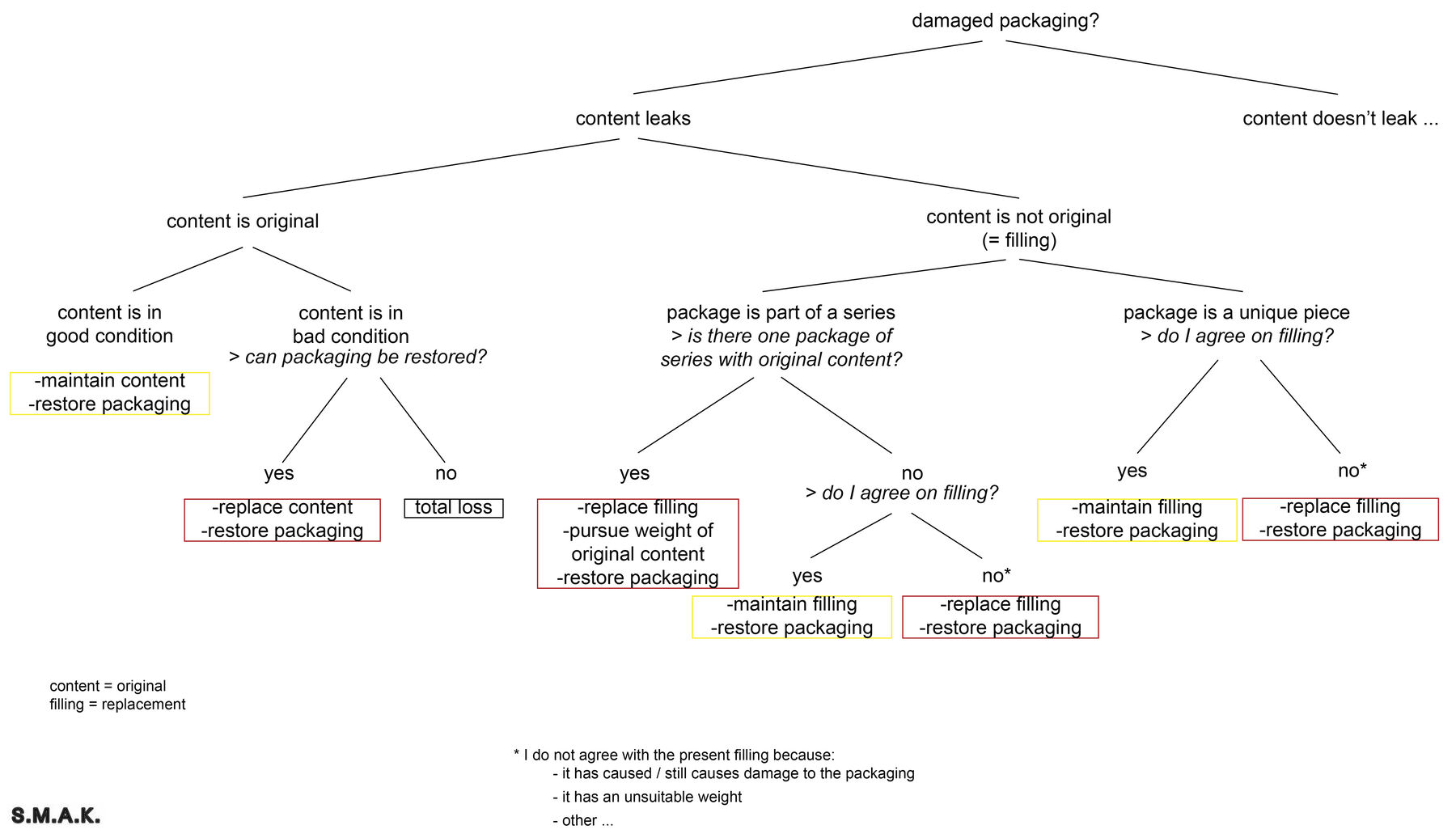 Figure 17.7
Figure 17.7The next step is a consideration of a material that gives the packaging the “look and feel” it had with its original enclosed matter. Günter Schott, a former conservator at the Hessisches Landesmuseum Darmstadt who often worked with Beuys, and even restored some works together with the artist, said that to him, it is clear that when restoring works by Beuys, “one cannot use any material that looks like the original but being something else. One should always use the original material” (, 72). In the case of Wirtschaftswerte, the condition of the original packaging makes it ineligible for replacing non-original content with new, “original” content. If the package is unique, the suitability of the current contents is evaluated. If it has caused or still causes damage to the original packaging, or when the weight of the whole doesn’t match the information on the packaging (for instance if a one-kilo bag of salt is filled with polystyrene balls), this can be defined as an unsuitable filling.
If the content of a package doesn’t leak, decision-making proceeds on the right side of the model (fig. 17.8). The next question asks whether the content is visible. If yes, this is due either to the shape of the package or to serious damage. The next steps are then identical to the left side of the decision tree as in the case of lost content. If the content is not visible, the packaging is usually barely or only superficially damaged. If the content is not authentic, then opening the package is considered along with the accompanying risks: if further treatment poses more risk to the package than the non-original content, the package is left untouched. When a treatment is simple and without further risk to the packaging, the branch continues and the uniqueness of the package is assessed. The further outcome is similar to those mentioned elsewhere in the decision model.
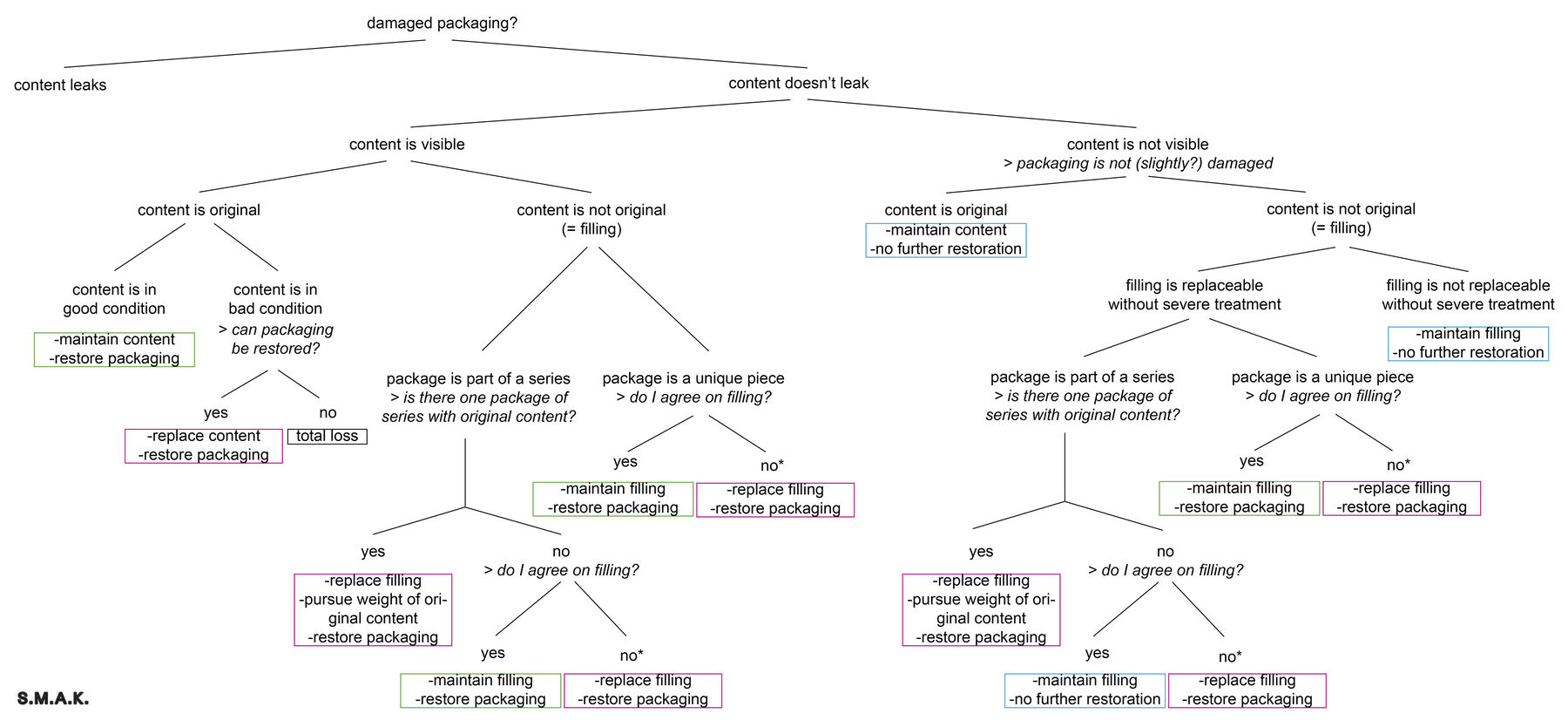 Figure 17.8
Figure 17.8The division will finally result in five different treatment proposals, which concern both the restoration of the packaging and the preservation of its contents. In addition, it is also defined when a package should be considered a total loss. The more severe the damage, the more urgent it is to carry out a restoration treatment. The five treatment proposals each have a different color code, which corresponds to the urgency of treatment (fig. 17.9). Red and yellow indicate the most urgent treatments, and green and blue indicate the least urgent; pink is in the middle. The urgency is unconnected to whether the content of the package is original. As mentioned earlier, the most crucial question is if the content leaks or not.
Conclusion
The development of this decision-making model was challenging due to the many different aspects of the research and different opinions on treatment, but it was essential to take the past and present condition of this installation into account in order to think in an organized manner about its future. Because Wirtschaftswerte will continue to degrade, it is certain that this “patient” will need ongoing care. There is a lot of work still to be done, and S.M.A.K. is aware that the time and budget necessary for realizing treatments will be spread over several years. Now that the decision tree exists, it is possible to carry out future treatments following the same decision-making pattern—a pattern that is consistent with the vision of the museum. In this way it is hoped that Wirtschaftswerte can be exhibited for as long as possible, while avoiding future damage and having a consistent plan in place should damage occur.
Acknowledgments
Many thanks to Eva Bader, Rachel Barker, Frances Berry, Gesine Betz, Katrien Blanchaert, Dr. Carolin Bohlmann, Charlotte Bouteligier, Leonie Colditz, Nav Haq, Frederika Huys, Sebastian Köhler, Claudia Kramer, Iris Paschalidis, Dirk Pauwels, Eva Rieß, Philippe Van Cauteren, and Thibaut Verhoeven for your help and inspiring ideas during the research.
Notes
It is clear that this particular work mostly concerns contrasts between East and West Germany, but Beuys’s ideas about Wirtschaftswertprinzip concern the contrasts between East and West on a global scale. ↩︎
Gerhard Steidl is the founder of the Steidl publishing house, which together with Klaus Staeck put out the book Joseph Beuys – Das Wirtschaftswertprinzip (1990/1997). ↩︎
Personal communication to author, May 8, 2019, from Frederika Huys of the Protocol Room, formerly S.M.A.K. ↩︎
Personal communication to author, February 6, 2019, from Véronique Van Bever, a colleague at S.M.A.K. who worked at the museum at the time this treatment happened. ↩︎
Oral and written communications were conducted with Rachel Barker (Rachel Barker Associates), Sebastian Köhler (Kaiser Wilhelm Museum, Krefeld), Leonie Colditz (freelance conservator), Eva Rieß (Hamburger Bahnhof Museum für Gegenwart, Berlin), Dr. Carolin Bohlmann (Hamburger Bahnhof Museum für Gegenwart, Berlin), Gesine Betz (Hessisches Landesmuseum, Darmstadt, Germany), Eva Bader (Das Städel Museum, Frankfurt am Main, Germany), Nav Haq (M HKA, Antwerp, Belgium), Frederika Huys (Protocol Room, formerly S.M.A.K.), Dirk Pauwels (formerly S.M.A.K.), and others. ↩︎
Bibliography
- Bader 2017
- Bader, Eva. 2017. “Die ‘Barraque D’Dull Odde’ 1961–67 von Joseph Beuys. Dokumentation, Oberflächenreinigung und Sicherung einer ortsspezifischen Installation im Vorfeld der Sanierung des Kaiser Wilhelm Museums in Krefeld.” ZKK Zeitschrift für Kunsttechnologie und Konservierung 31 (2): 203–24.
- Barker and Bracker 2005
- Barker, Rachel, and Alison Bracker. 2005. “Beuys Is Dead: Long Live Beuys! Characterising Volition, Longevity, and Decision-Making in the Work of Joseph Beuys.” Tate Papers, no. 4 (Autumn): https://www.tate.org.uk/research/publications/tate-papers/04/beuys-is-dead-long-live-beuys-characterising-volition-longevity-and-decision-making-in-the-work-of-joseph-beuys.
- Berlinghof 2014
- Berlinghof, Harald. 2014. “BLOCK BEUYS Erinnerungen von Günter Schott 1969 bis 2010 Restaurator am Hessischen Landesmuseum Darmstad.” Interview by Inge Lorenz, Jan Peter Thorbecke, and Klaus-D. Pohl. Darmstadt, Germany: Hessisches Landesmuseum Darmstadt.
- Blanchaert 2014
- Blanchaert, Katrien. 2014. “Joseph Beuys – Wirtschaftswerte (1980).” In Kunst in Europa na ’68 = Art in Europe after ’68 Ghent / 21st June–31st August 1980, edited by S.M.A.K., 177–94. Ghent: S.M.A.K.
- Foundation for the Conservation of Modern Art and the Institute for Cultural Heritage 1999
- Foundation for the Conservation of Modern Art and the Institute for Cultural Heritage. 1999. “The Decision-Making Model.” In Modern Art: Who Cares? An Interdisciplinary Research Project and an International Symposium on the Conservation of Modern and Contemporary Art, edited by Ijsbrand Hummelen, Dionne Sillé, and Marjan Zijlmans, 164–72. Amsterdam: Foundation for the Conservation of Modern Art.
- Gilman 2015
- Gilman, Julie. 2015. “The Role of Science in Contemporary Art Conservation: A Study into the Conservation and Presentation of Food-Based Art.” PhD diss., Ghent University Faculty of Arts and Philosophy.
- Hoet and De Baere 1990
- Hoet, Jan, and Bart De Baere. 1990. “Ekonomische Waarden.” In Joseph Beuys – Das Wirtschaftswertprinzip, edited by Klaus Staeck and Gerhard Steidl, 21–25. Heidelberg, Germany: Edition Staeck.
- Verhoeven 2019
- Verhoeven, Thibaut. 2019. “Joseph Beuys – Wirtschaftswerte (1980).” In S.M.A.K. De Collectie A–Z, edited by S.M.A.K., 149. Ghent: S.M.A.K.
